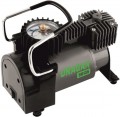The maximum pressure provided by the pump or compressor — in other words, the highest tyre pressure that can be achieved using this unit.
In most models, this figure is
from 2.5 to 10 atm, and in mechanical pumps (manual and foot, see "Type") pressure of more than 10 atm is practically not found at all. This is due to the fact that even for heavy trucks, the optimal tyre pressure is usually about 5 – 9 atm (depending on a number of parameters — there are special formulas and tables for calculations); and in passenger car tyres, a pressure of more than 2.5 atm is extremely rarely used. However, there are compressors with higher pressure parameters —
11 – 15 atm,
16 – 20 atm and even
higher. The meaning of such characteristics is mainly in the "power reserve": a higher working pressure contributes to faster pumping. However, be careful not to over-inflate the tyre and damage it.
Function that
automatically stops operation when a sufficient level of tyre pressure is reached. Usually, the pressure at which the auto-stop is triggered can be set at the discretion of the user.
This function greatly simplifies the work with the pump: the risk of overfilling the tyre is reduced to almost zero, while the user does not need to monitor the pumping process, because the pump will stop at the right time. On the other hand, hitchhiking significantly affects the price. It is found only in electric compressors (see "Type").

